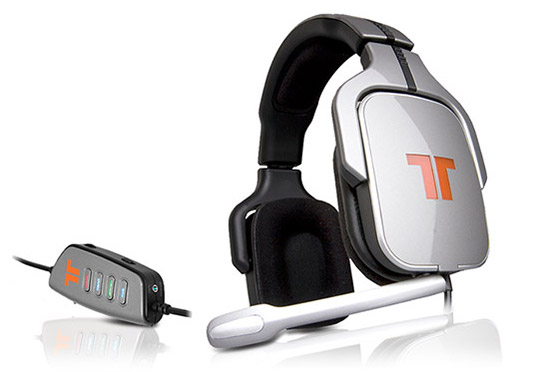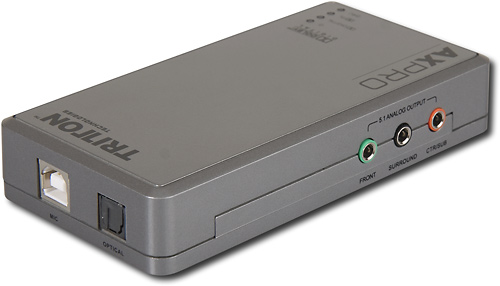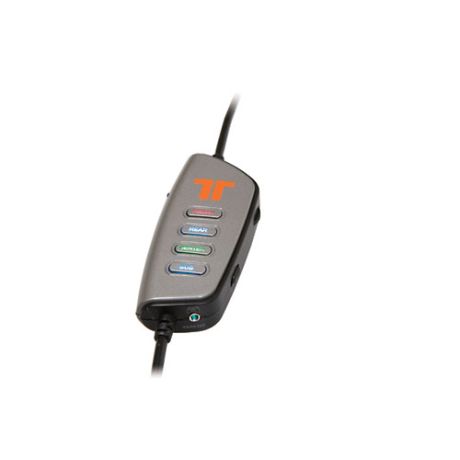Tritton AX Pro Gaming Headset Review

Does this 5.1 headset bring an audible feast to our ears? Find out in our full review.
I've had an opportunity to use and review a wide variety of gaming headphones in my time here at IGN. I've had my ears in nearly every type, make, and model available, but none seem to get the concept entirely correct. It seems that most manufacturers have a hard time balancing affordability and quality, and an even harder time maintaining simplicity without sacrificing features. But credit must be given where it is due, and manufacturers do make a commendable effort toward perfecting the formula with each new model and iteration. On one end of the spectrum you have Turtle Beach's X-series, which keep improving on the affordable market, and on the other you have Astro Gaming's A-series, which have a firm grip on the high performance market. Somewhere in between you can find Tritton, whose specialty seems to be the middle ground.
In the past, Tritton's headphones have been regarded as reasonably featured and moderately priced audio solutions geared toward both enthusiast and hardcore gamers alike. The earliest models offered by Tritton were exclusive to PC users, but the company broke into the console market with their AX360 model, which boasted 5.1 surround sound and compatibility with PC, Xbox 360, and PlayStation 3. While IGN has never published a complete review of the AX360, I felt that it was somewhat uninspiring in both style and usability. Fortunately, it would seem that Tritton recognized these issues with the AX360 and made a significant effort to remedy them with the AX Pro.


Beyond the optical connection and AC connections, the remainder of the setup is relatively simple; the headphones connect to the input pod via a 9-pin cable and the microphone connects to the Xbox 360 via a 1/8" headphone cable from the inline volume controller to the Xbox 360 controller. PlayStation 3 microphone communications are even simpler and connect via a USB port built into the input pod.

Once calibrated to your liking, the audio quality of the AX Pros really begins to show. The audible experience could best be described as roomy. Unlike most other 5.1 models, which cram the sound into one loud mess, the AX Pro creates a largely three-dimensional experience. When using the AX Pros with quality directional source audio, such as Infinity Ward's Call of Duty 4, you can really get a feel for the audible location of various aspects of your environment. Paired with the stunning visual presentation of most current-gen games and films, the AX Pro creates some of the richest audible environments I've experienced in a pair of multi-channel headphones.

As for the physical characteristics of the headphones, there is a lot to like. The AX Pros are exponentially more stylized than Tritton's other headphone solutions. The AXPro has a streamlined silver-on-black aesthetic with illuminated orange logo accents built in to the side of both ear cups. The ear cups of the AX Pro swivel, the microphone is detachable, and the headband is completely adjustable, but the unit looks as if it could be made of a solid piece of plastic. The microphone connects to the base of the left ear cup via a locking mechanism, which is enable by simply inserting and twisting the microphone arm. All of the necessary audio connections for the microphone are made simultaneously when you snap in the microphone. In terms of comfort, the AX Pro's ear cups are large and breathe exceptionally for prolonged gaming sessions. To make things even more personalized, users can swap out the ear cups from soft fabric padding to a set of padded pleather-like ear cups.

Although there is much to like about the AX Pro, there are a few features I would have liked to have seen. For starters, I would have liked a wireless solution from Tritton. Granted, wireless technology degrades the performance and jacks up the price, it is an invaluable feature for some. In this particular case, keeping wireless out of the formula makes sense in order to keep it in the sub-$200 range, but I'd like to see it in future models. A more immediate issue I found with the AX Pro was the absence of voice monitoring. While not exactly a deal breaker, I would have liked to been able to hear myself during voice communications. Too often I found myself speaking or shouting louder than intended during use because I was unable to accurately measure the volume of my voice amidst the in-game effects. But ultimately, the absence of voice monitoring is a matter of preference.
Overall, the Tritton AX Pro is an exceptional piece of gaming equipment. The sound performance is pristine and users can easily tweak it to their liking. Granted, setting up the system can be more complicated than other solutions, but it's worth the trouble. There are a few absent features that I would have liked to have had available to me, but for the price (a modest $179.99), the AX Pro can't be beat.

IGN Ratings for Tritton AX Pro Gaming Headset
8.3 Build Quality
- Strong plastic construction that seems as if it could be made of one single block.
9.0 Audio Quality
- Rich, deep, and three-dimensional.
8.6 Features
- A nice collection of audio settings.
7.4 Ease of Use
- A bit of a hassle to set up, but nothing too complicated.
8.2 Value
- For the price, the AX Pro is hard to beat.
8.4 Comfort
- Perfect for extended gaming sessions
8.8 Great
OVERALL (Out of 10)
Overall, the Tritton AX Pro is an exceptional piece of gaming equipment. The sound performance is pristine and users can easily tweak it to their liking. Granted, setting up the system can be more complicated than other solutions, but it's worth the trouble. There are a few absent features that I would have liked to have had available to me, but for the price (a modest $179.99), the AX Pro can't be beat.

8.3 Build Quality
- Strong plastic construction that seems as if it could be made of one single block.
9.0 Audio Quality
- Rich, deep, and three-dimensional.
8.6 Features
- A nice collection of audio settings.
7.4 Ease of Use
- A bit of a hassle to set up, but nothing too complicated.
8.2 Value
- For the price, the AX Pro is hard to beat.
8.4 Comfort
- Perfect for extended gaming sessions
8.8 Great
OVERALL (Out of 10)